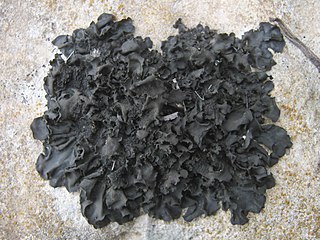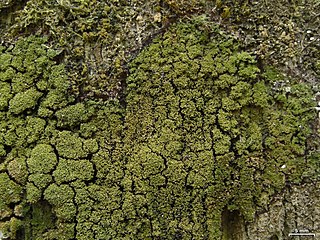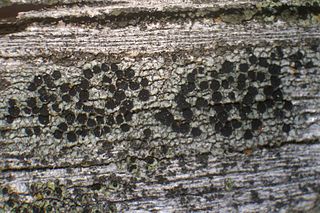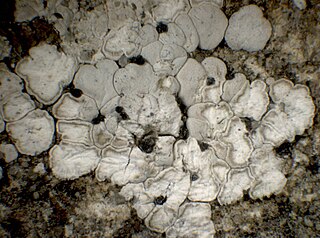Scutula is a genus of lichenicolous fungi in the family Ramalinaceae.

Collema is a genus of lichens in the family Collemataceae. The photobiont is the cyanobacterium genus Nostoc. Species in this genus typically grow on nutrient-rich bark or somewhat siliceous or calcareous rocks in humid environments.

The Psoraceae are a family of lichenized fungi in the order Lecanorales. The Austrian Botanist and Lichenologist Alexander Zahlbruckner first described the family in 1898. Species of this family have a widespread distribution.

Phyllopsora is a genus of lichen-forming fungi in the family Ramalinaceae. It was circumscribed by Swiss botanist Johannes Müller Argoviensis in 1894, with Phyllopsora breviuscula assigned as the type species.

Buellia is a genus of mostly lichen-forming fungi in the family Caliciaceae. The fungi are usually part of a crustose lichen. In this case, the lichen species is given the same name as the fungus. But members may also grow as parasites on lichens (lichenicolous). The algae in the lichen is always a member of the genus Trebouxia.

Phaeophyscia is a genus of lichen-forming fungi in the family Physciaceae.

Calvitimela is a lichen genus in the family Tephromelataceae. Members of the family Tephromelataceae are crustose lichens with green photobionts and lecideine or lecanorine apothecia. The species in Calvitimela have lecideine apothecia, are saxicolous and are primarily found in alpine to arctic regions.
Teuvoa is a genus of lichen-forming fungi in the family Megasporaceae. It was first classified by lichenologists Mohammad Sohrabi and Steven Leavitt in 2013, with Teuvoa uxoris asigned as the type species. This genus was delineated from the larger genus, Aspicilia, following a molecular phylogenetic analysis which revealed that the Aspicilia uxoris species group constituted a distinct lineage in the Megasporaceae. Initially containing three species, two additional species native to China were added in 2018. Teuvoa is characterised by its small ascospores and conidia, and the absence of secondary metabolites.
Waynea cretica is a species of corticolous (bark-dwelling), squamulose lichen in the family Ramalinaceae. It occurs on the Greek island of Crete and in Portugal.

Psora taurensis is a species of terricolous (ground-dwelling), squamulose lichen in the family Lecanoraceae. It is found in the Taurus Mountains of Turkey.

Rostania is a genus of lichen-forming fungi in the family Collemataceae. These lichens are primarily found on tree bark, occasionally on wood, with one species known to inhabit soil. The genus is characterized morphologically by having minute thalli made of hyphal tissue without a separate cortex, and the more or less cuboid-shaped ascospores.

Psora altotibetica is a species of terricolous (ground-dwelling), squamulose lichen in the family Psoraceae. It occurs in the Tibetan region of China and in Nepal. The species bears a resemblance to Psora indigirkae but is genetically closer to Psora tenuifolia and Psora vallesiaca. It differs from the rest in certain features such as the colour of its apothecia, size of ascospores, and secondary chemical composition. The lichen's habitat is in the alpine zones of the Great Himalayas at altitudes between 4,230 and 5,000 m.
Calogaya orientalis is a species of corticolous (bark-dwelling) and muscicolous lichen (moss-dwelling), crustose lichen in the family Teloschistaceae. It is found in arid steppe and desert habitats in Northwestern China, Iran, and Turkey. The thallus of this lichen is reduced, similar to species in the genus Athallia.
Schaereria bullata is a species of lichen in the family Schaereriaceae. It is found in the alpine regions of Tasmania, Australia. This lichen species is characterized by its dark brown to grey-brown thallus, which forms irregular patches over soil or bryophytes, and consists of granules that coalesce to create convex to bullate squamules. The lichen also features distinctive apothecia, which are roundish and typically superficial, and spherical spores.

Coniocarpon is a genus of lichen-forming fungi in the family Arthoniaceae. It has eight species of corticolous (bark-dwelling) lichens. This genus is distinct for its crystalline orange, red, and purple quinoid pigments in the ascomata that turn purple in potassium hydroxide solution, its colourless, transversely septate ascospores with large apical cells, and its rounded to lirellate ascomata.
Coenogonium flammeum is a species of corticolous (bark-dwelling), crustose lichen in the family Harpidiaceae. It is found in Argentina.
Amandinea pilbarensis is a little-known species of crustose lichen in the family Physciaceae, First described in 2020, it is found in Australia. It is similar to Amandinea polyxanthonica, but can be distinguished by its smaller ascospores and the presence of calcium oxalate and thiophanic acid in the medulla.
Pyrenodesmia micromarina is a species of saxicolous (rock-dwelling), crustose lichen in the family Teloschistaceae. It is found in the Eastern Mediterranean, specifically along the coasts of the Black Sea and the Sea of Marmara in Russia, Turkey, and Ukraine. It grows on coastal rocks and occasionally concrete, often in Mediterranean scrub vegetation.

Glaucomaria carpinea is a species of corticolous (bark-dwelling), crustose lichen in the family Lecanoraceae. It is a widely distributed species.

Porpidinia is a genus of lichen-forming fungi in the family Lecideaceae. It has two species of saxicolous (rock-dwelling) lichens. The type species of the genus, Porpidinia tumidula, thrives in a variety of settings from coastal to mountainous areas, primarily on lime-rich rocks, and is widely spread across southern to northern Europe, northern Africa, parts of Asia, and New Zealand. Meanwhile, Porpidinia brevispora is more regionally confined, found specifically in the Sikhote-Alin range in the Russian Far East, favouring carbonate rocks at lower altitudes.













